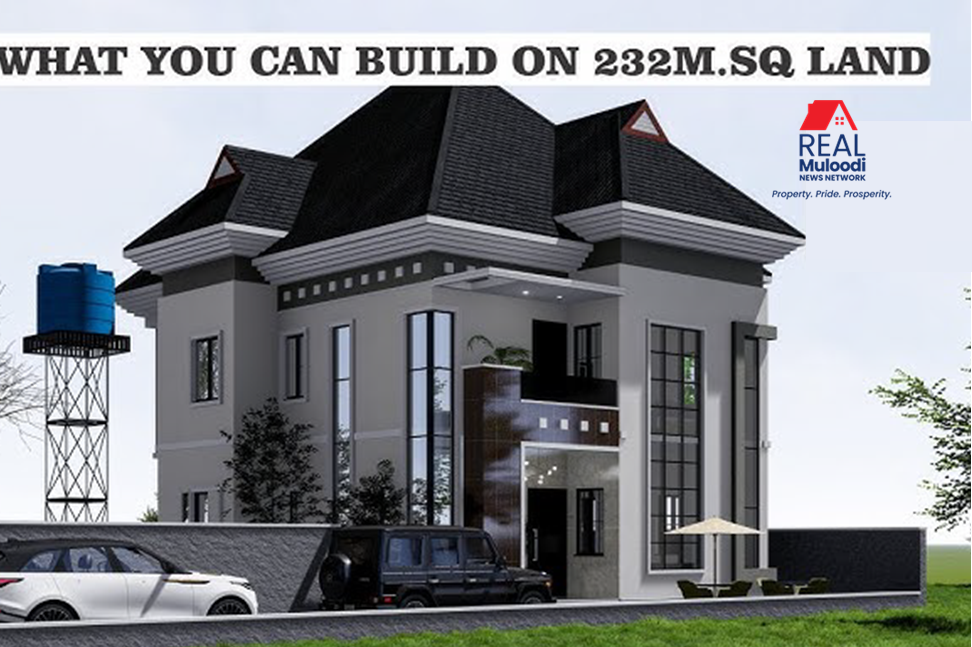UGANDA, Kampala | Real Muloodi News | Building a well-designed home on a small plot of land can present unique challenges and opportunities. While the cost of land in desirable areas often poses difficulties, efficient use of space allows for the construction of a comfortable and functional home. This guide outlines essential steps for navigating the home-building process, particularly on smaller plots.
Importance of Professional Guidance
Consulting professionals is crucial for the successful completion of any construction project. Derrick Semwanga, a civil engineer, stresses the necessity of hiring an architect to create an effective layout that maximises the use of limited space.
“Consult a professional to help you design your constrained space to meet your requirements,” Semwanga advises.
In addition, Brian Karala, a civil engineer at Vodo Construction Company Limited, highlights the importance of surveying the land before starting construction.
He recommends marking boundaries with stones or other markers and sharing these dimensions with the architect.
“This blueprint allows professionals to make visual estimations about the land, ensuring that the structure is firm and durable, especially in areas where the ground may be unstable,” he explains.
Understanding the land’s history is also vital for identifying potential construction issues, particularly on sites that may have been previously swampy or unstable.
Maximising Space Effectively
The shape of the building significantly impacts how effectively land is utilised. Experts recommend rectangular structures, as most small plots are typically rectangular, often measuring around 50 by 100 feet.
Semwanga advises, “Design the project to align with the shape of the land. For example, with a rectangular plot, utilise more of the length to create adequate space around the project.”
It is essential to adhere to local zoning laws regarding spacing during construction. Experts suggest maintaining a two-meter distance from neighbouring properties, with at least a one-meter gap at each end to ensure adequate working space.
Smart Building Strategies
Building up instead of out can help maximise land use without necessitating multi-storey constructions. Features such as high ceilings, large windows, and open-plan designs can create an illusion of more space indoors.
Smart choices, such as automated or sliding doors, can reduce congestion in smaller rooms. Semwanga states, “Consider building upwards rather than outwards to maximise land use.”
Incorporating space-saving features, such as built-in storage and wall-mounted fixtures, can also enhance functionality.
Kalara recommends positioning the building to face the windward side, optimising both natural light and ventilation. Using eco-friendly materials can add character to the home while supporting sustainability.
“Architecture should prioritise beauty while also considering environmentally friendly materials, such as quarry tiles or wooden flooring,” Kalara notes.
Regarding room dimensions, Semwanga advises that a bedroom should ideally measure at least 3 by 3 meters, while a living room should be no less than 4 by 5 meters.
Multi-purpose rooms can also be beneficial, adapting as family needs change. For example, a corner of the living room can be transformed into a reading nook with a small shelf and comfortable chair.
Outdoor Space Optimisation
Outdoor areas should not be overlooked in the design process. Semwanga suggests utilising corridors at the edges of the building for drainage and cable management.
“In sloped areas, these corridors can channel water effectively or serve as walkways,” he notes.
A well-designed outdoor area fosters a connection with nature. If extensive landscaping seems impractical, flower arrangements and vertical gardens can add greenery without consuming much ground space.
Kalara encourages maintaining a garden regardless of the area’s size, suggesting the use of small pots and eco-friendly materials.
“Not everything needs to be plastered or painted; natural stones can be effectively incorporated into walls and floors,” he advises.
Building a well-designed home on a small plot of land requires careful planning, professional guidance, and innovative design solutions.
By focusing on maximising space through effective layouts, smart building strategies, and thoughtful outdoor design, homeowners can create functional and aesthetically pleasing living environments.
With attention to detail and a strategic approach, constructing a well-designed home that meets personal needs and enhances the surrounding community is achievable.
READ MORE LIKE THIS:
VIDEO: 4 Bed 3 Bath Home on 50ft x 100ft (15m x 30m) Lot, Built to Completion in 6 months



